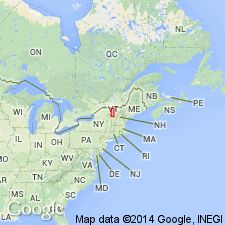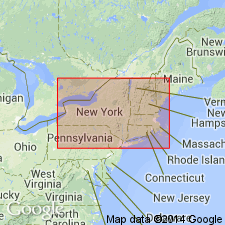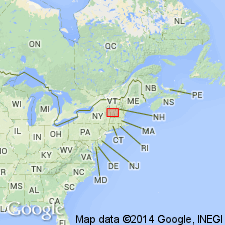
- Usage in publication:
-
- Monkton quartzite*
- Modifications:
-
- Original reference
- Dominant lithology:
-
- Quartzite
- Shale
- Dolomite
- AAPG geologic province:
-
- New England province
Summary:
Pg. 106. Monkton quartzite. Oldest formation in central sequence. Base not known, because lowest red beds rest on Ordovician rocks along a thrust-fault plane. Named for town of Monkton, 20 miles nearly south of Burlington, where relations to overlying beds are well shown. Is almost wholly quartzite, in layers from a few Inches to 3 feet thick. A few seams and beds of reddish or purplish shale most of them only a few inches thick, are interbedded with the quartzite in lower part of formation. The quartzite has a decided reddish color, varying from reddish brown through brick red and purple to light shades of red, pink, buff, and white; the white beds are more numerous at top, especially north of Burlington, where they are as important as the vari-colored beds. In upper part of formation a few thin layers of gray or pink dolomite form transition to overlying Winooski marble. Quartz conglomerate in thin layers has been reported from a few places by several geologists but has not been observed by writer. Full thickness of formation unknown, but 300 feet are seen in sections in Colchester Township. Contains Lower Cambrian fossils (trilobites). Adopted by the USGS.
Named for town of Monkton, Addison Co., 20 mi nearly south of Burlington, northwestern VT. Outcrop is marked by hills, low mountains, and cliffs (especially along Lake Champlain) due to its resistance to erosion. Forms several anticlines at Monkton. Absent north of La Moille River, north of Burlington, where it is cut out along several faults. Disappears at south end of Snake Mountain.
Source: US geologic names lexicon (USGS Bull. 896, p. 1399); supplemental information from GNU records (USGS DDS-6; Reston GNULEX).

- Usage in publication:
-
- Monkton Formation*
- Modifications:
-
- Revised
- AAPG geologic province:
-
- New England province
Summary:
Monkton Formation used in southwestern VT. [Monkton Quartzite remains good usage elsewhere.]
Source: GNU records (USGS DDS-6; Reston GNULEX).

- Usage in publication:
-
- Monkton Formation*
- Modifications:
-
- Areal extent
- AAPG geologic province:
-
- New England province
Summary:
Stratigraphic succession in Middlebury synclinorium in north-central part of Glens Falls quad consists of (ascending) Late Proterozoic Dalton Formation and Pinnacle Formation, Lower Cambrian Cheshire Quartzite, Lower and Middle Cambrian dolomites (Rutland Dolomite, Dunham Dolomite as used by Cady (1945), Winooski Dolomite) with minor quartzite (Monkton Formation), and Upper Cambrian Danby Formation. Middlebury synclinorium is considered a parautochthonous shelf sequence.
Source: GNU records (USGS DDS-6; Reston GNULEX).
For more information, please contact Nancy Stamm, Geologic Names Committee Secretary.
Asterisk (*) indicates published by U.S. Geological Survey authors.
"No current usage" (†) implies that a name has been abandoned or has fallen into disuse. Former usage and, if known, replacement name given in parentheses ( ).
Slash (/) indicates name conflicts with nomenclatural guidelines (CSN, 1933; ACSN, 1961, 1970; NACSN, 1983, 2005, 2021). May be explained within brackets ([ ]).

